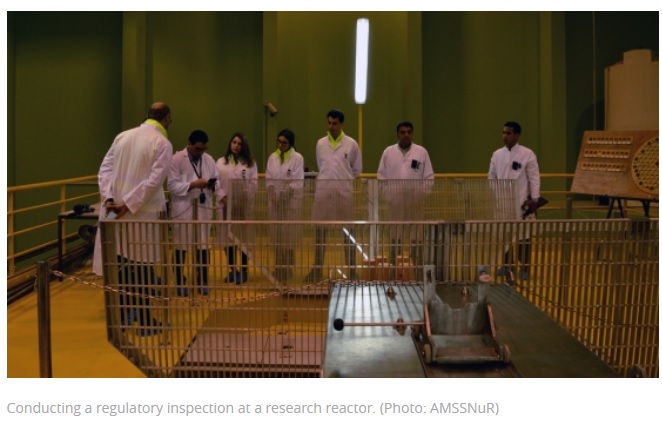Laura Gil, IAEA Office of Public Information and Communication
Research reactors may be smaller, simpler and require less fuel than a nuclear power reactor, but they still need to adhere to rigorous safety and security regulations.
“Any activity or practice involving ionizing radiation sources, unless exempted or excluded from a regulatory regime, has to be regulated and controlled. If it is not controlled, it could do more harm than good,” said Khammar Mrabit, Director General of the Moroccan Nuclear and Radiation Safety and Security Agency (AMSSNuR). “To ensure safety and security, you need regulatory supervision.”
Any activity or practice involving ionizing radiation sources, unless exempted or excluded from a regulatory regime, has to be regulated and controlled. If it is not controlled, it could do more harm than good. Khammar Mrabit, Director General, Moroccan Nuclear and Radiation Safety and Security Agency (AMSSNuR)
Supporting regulatory authorities around the world in ensuring nuclear safety and security of research reactors is one of the IAEA’s key functions. In the case of Morocco, which operates a TRIGA Mark II research reactor, the IAEA has helped the regulatory body become an example of robust inspection, independence and reliability.
The TRIGA Mark II research reactor, which is part of the National Centre for Nuclear Energy, Sciences and Technology (CNESTEN), began operation in 2007. The country’s nuclear law, enacted in 1971, and its law on civil liability, enacted in 2005, did not foresee potential threats such as nuclear terrorism, and, according to Mrabit, the regulatory body at the time did not have sufficient independence so it turned to the IAEA for help.
“On the one hand, you have legislation and regulations and, on the other, you have the operators, who are primarily responsible for safety. In the middle and continuously, you need an independent regulatory body with clear functions, roles and responsibilities to, for example, authorize and inspect,” Mrabit said.
The IAEA supported Morocco in elaborating and enacting a new nuclear law in 2014 and in creating a new, independent regulatory body under the country’s Prime Minister. In 2016, AMSSNuR experts developed a strategic action plan to upgrade their regulatory system. Over 30 stakeholders from the relevant ministries, professional organizations, technical support institutes and the IAEA were involved in the process.
The TRIGA Mark II research reactor is Morocco’s biggest nuclear installation and is therefore a high priority for authorities and technical experts in the country. It contributes to various activities, including research and training in nuclear medicine, industrial applications and radioactive waste management. The IAEA’s support in regulatory supervision includes review missions, assistance with developing regulations and technical expertise.
Morocco has also become a training hub for regulatory supervision of research reactors in North Africa and beyond.
“You need to have a clear vision and plan,” said Farhana Naseer, a nuclear safety officer at the IAEA. “Morocco has had a coherent, strategic and graded approach since day one. The country’s experience will serve as a good source of best practices and as a model for other countries.”
FORO
Countries in other regions, too, are sharing best practices on regulatory supervision of research reactors. For example, the regulatory bodies of FORO — the IberoAmerican Forum of Radiological and Nuclear Regulatory Agencies — are sharing their own best practices and supporting one another in the area of regulatory inspection as part of a joint project.
“The idea is that we exchange experience and have common regulatory criteria for all reactors,” said Gerardo Lázaro, coordinator of the project and the expert responsible for the inspection of research reactors at the Peruvian Institute of Nuclear Energy. “We have been working very well for 30 years, using the IAEA standards as our reference,” he said. “There is significant experience at all the research reactors throughout the region. It is important we share that experience and the knowledge we have gained so that we continue to improve.”
The goal of the project is, with the IAEA’s support, to produce a standardized inspection manual in Spanish for operators of nuclear research reactors. The manual is expected to be finalized in 2020 and will be complemented with reference regulatory guidance on the oversight of research reactors’ ageing management. Ageing is of growing interest because all research reactors in FORO countries have accumulated several years of operation.
There are 16 research reactors currently in operation across 9 Latin American and Caribbean countries, 15 of which are in FORO countries. These reactors provide essential services, ranging from academic research and education to applications in agriculture and the environment and the production of radioisotopes for use in medicine and industry.
This article was also featured in the IAEA Bulletin on Research Reactors published in November 2019.







